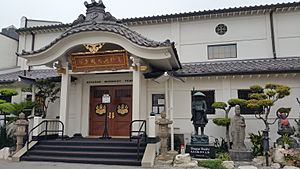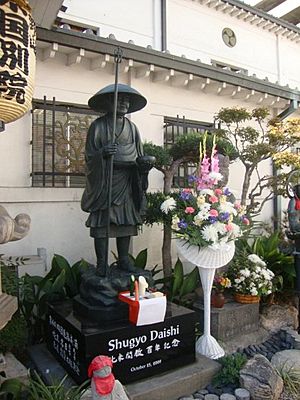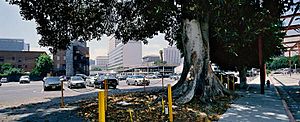Koyasan Buddhist Temple facts for kids
Quick facts for kids Koyasan Buddhist Temple |
|
|---|---|

Koyasan Temple in 2016
|
|
| Religion | |
| Affiliation | Shingon Buddhism |
| Location | |
| Location | 342 East 1st Street Los Angeles, California 90012 |
| Country | United States |
| Architecture | |
| Founder | Rev. Shutai Aoyama |
| Completed | 1912 |
| Website | |
| Official Website: http://www.koyasanbetsuin.org/ Official Facebook Page: http://www.facebook.com/lakoyasanbetsuin |
|
Koyasan Beikoku Betsuin (高野山米国別院, Kōyasan Beikoku Betsuin, "Koyasan United States Branch Temple"), also known as Koyasan Buddhist Temple, is a special Japanese Buddhist temple. It is located in Little Tokyo, a neighborhood in Downtown Los Angeles, California, USA. This temple was started in 1912, making it one of the oldest Buddhist temples in North America! It is a main center for Shingon Buddhism in North America, connected to the important Koyasan mountain in Japan.
Contents
History of Koyasan Buddhist Temple
Starting the Temple in Los Angeles
In 1909, a priest named Reverend Shutai Aoyama came to the United States from Japan. He wanted to learn about religion in North America and share Shingon Buddhism. In 1912, with help from the Japanese community in Los Angeles, he opened the first Shingon temple in the United States. It was in a storefront in Little Tokyo. People called it Koyasan Daishi Kyōkai of Los Angeles, or just Daishi Church. Shingon Buddhism focuses on teachings put together by Kobo Daishi (Kukai).
Becoming a Headquarters and Facing Challenges
In 1935, the temple became very important. It was named Koyasan Beikoku Betsuin, which means it was the main headquarters for North America. This was recognized by the Koyasan Headquarters in Japan. In 1940, the temple moved to its current spot on East 1st Street.
However, things changed a lot after the Attack on Pearl Harbor in 1941. Many Japanese American people faced unfair treatment. The temple in Los Angeles had to close. Its halls were filled with members' belongings. Many Japanese Americans, including temple members, were sent to internment camps during World War II.
Growth and Special Events
After the war, the temple slowly reopened. Over the years, it started offering cultural and religious programs. Before Little Tokyo was redeveloped in the 1980s, Koyasan was a main place for Japanese cultural events.
In 1987, the temple held a very special ceremony called Kechien Kanjo. This ritual is rarely done outside of Japan. Two years later, in 1989, the temple became the keeper of the Hiroshima Peace Flame. This flame was brought from Japan by Los Angeles Mayor Tom Bradley.
Starting in 1999, the temple went through a ten-year renovation. This was to update the old buildings and meet city safety rules. The building was specially prepared for the monthly Goma fire ritual service. In 2012, the temple celebrated its 100th birthday! A special goma fire ritual was led by Bishop Ekan Ikeguchi from Japan. In 2022, the temple celebrated its 110th anniversary with a special ceremony for its members.
Temple Building and Features
The first temple was a storefront in 1912. In 1920, the temple moved to a bigger building on Central Avenue. A tree was planted there by temple members to remember the move. This tree, called the Aoyama Tree, is a huge Moreton Bay Fig tree. It is a famous landmark in Little Tokyo and was given historical status in 2008. Sadly, this tree has faced neglect over the years. After the old temple building was torn down, the tree was left without enough water. The area around its roots was paved over, making it hard for the tree to get water.
Inside the Current Temple
The current temple building has a main hall and an annex. The main hall is very large, about 60 by 120 feet. It can seat 600 people. It has a grand altar where traditional Buddhist rituals are performed. The main Buddha statue in the main hall is Dainichi Nyorai. There are also statues of other important Buddhist figures like Fudo Myoo, Yakushi Nyorai, Jizo, Kannon, and Kobo Daishi.
The second floor of the annex is a shrine to Kobo Daishi. It is called the “Daishi-Do,” or the "Hall of Daishi." This space is used for religious gatherings and study classes for smaller groups. It can hold about 100 people.
The temple basement is under the main altar. It is used as a meeting room for scouting activities. The temple also has an office, meeting rooms, a reception area, a kitchen, and classrooms for its daily operations.
Temple Leaders (Bishops)
The Koyasan Buddhist Temple has had many head bishops since it started in 1912. Two bishops, Reverends Seytsu Takahashi and Ryosho Sogabe, are known for helping to create the temple we see today. Reverend Seytsu Takahashi worked hard to raise money for a new temple building.
Reverend Taido Kitagawa helped start the temple's Boy Scout Troop 379. This is one of the oldest Boy Scout troops in the United States. Reverend Taisen Miyata was the seventh bishop. He also translated Buddhist texts. He served from 1993 to 2007 and again from 2011 to 2013.
Here is a list of the head bishops:
- Rev. Shutai Aoyama (1909-1921)
- Rev. Hokai Takada (1921-1924)
- Rev. Taido Kitagawa (1924-1933)
- Rev. Seytsu Takahashi (1931-1982)
- Rev. Ryosho Sogabe (1982-1991)
- Rev. Chiko Inouye (1991-1993)
- Rev. Taisen Miyata (1993-2007)
- Rev. Seicho Asahi (2007-2011)
- Rev. Taisen Miyata (acting: 2011–2013)
- Rev. Junkun Imamura (2015–2019)
- Rev. Yuju Matsumoto (2020–present)
Boy Scout Troop 379

The temple is also home to Boy Scout Troop 379. This troop was formed in 1931, making it one of the oldest troops in California! Famous actor and activist George Takei was once a member of this troop.
The troop has had other names, like AL Post 525, Koyasan, and Green Giant. The Commodore Perry Scouts were a marching and maneuvering group from Los Angeles. They were supported by the Commodore Perry American Legion Post 525 and the Koyasan Buddhist Temple.
In 1935, the Boy Scout Troop 379 had 164 Eagle Scouts. The group won state American Legion Championships in 1955, 1956, 1962, and 1963. Their colors are green, black, and white.
The troop was even in a movie! In the 1953 film, Mister Scoutmaster, members of Koyasan Troop 379 played the troop. In the movie, they helped search for a missing boy.
Later, in 1971, the Drum & Bugle Corps changed its name to Third Generation. This was because the members were not from the first or second generations of Japanese Americans.
See also


